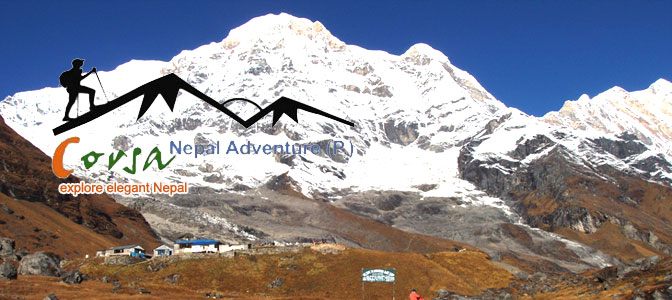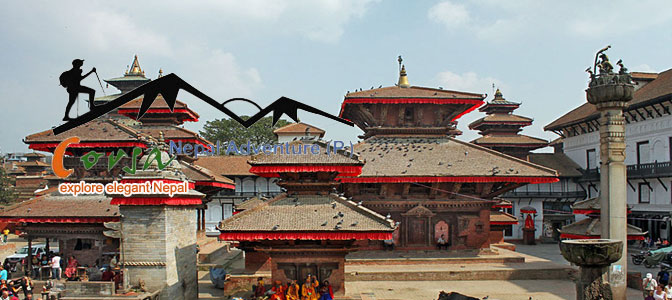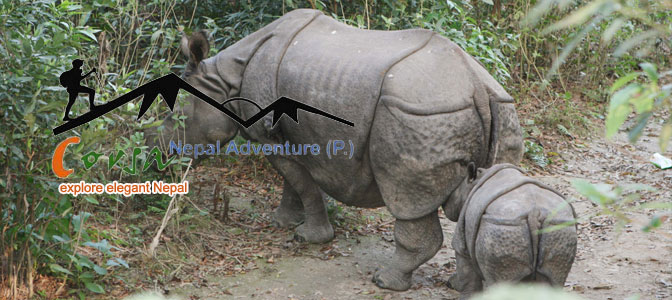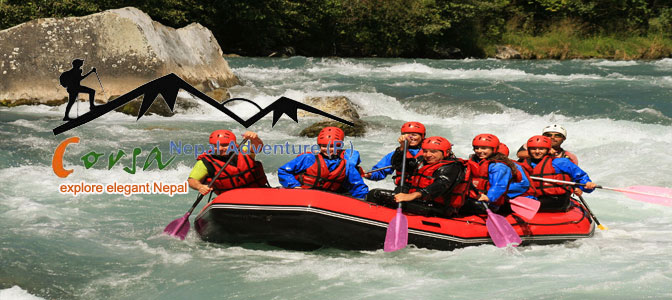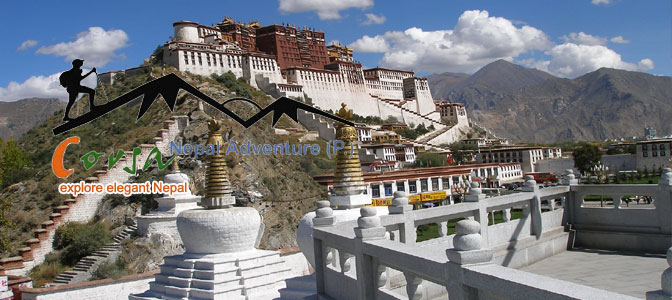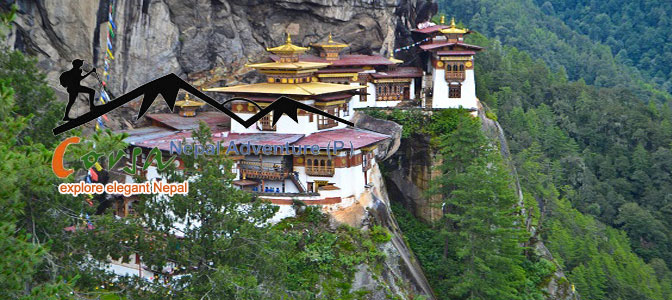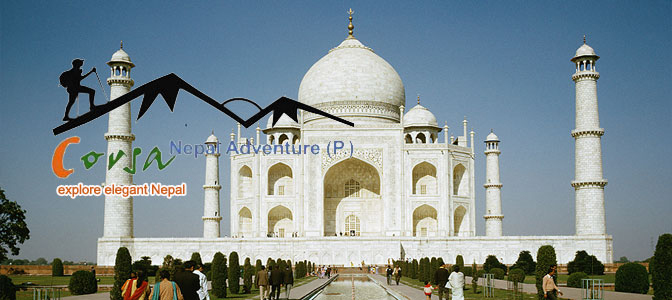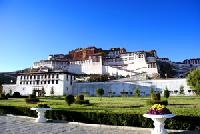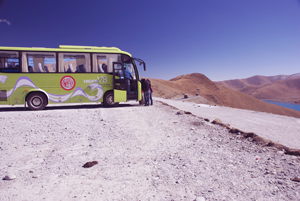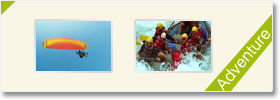Tibet Major Attraction
Lhasa (The Land of Gods)
Lhasa is the capital of Tibet. Bordered by the north bank of the Kyichu River, Lhasa is at an altitude of 3,650m above sea level. Its 1,300-year old history has put it at the center of politics, economy, culture and religion in Tibet since ancient times. There are numerous scenic spots and famous historical attractions among which Potala Palace, Norbulingka, Drepung Monastery, Sera Monastery, Ramoche Temple, Jokhang Temple and Barkhor Street Market.
Jokhang Temple
Four storied temple of Golden Splendor featuring architecture of the Tang Dynasty from the 7th century AD. Murals and historical relics depict famous figures and stories from the past. Located in the center of the old Lhasa city, Jokhang Temple is the first monastery for most pilgrims to visit as it is widely recognized as the spiritual center of Tibetan Buddhism. The temple was built in 647. Every day you would see many pilgrims who trek a long distance from other places of Tibet here worshiping Buddhist by prostrating to body\'s length. Around the temple is the famous Barkhor Street where you can get a close touch with local Tibetan people.
Norbulinka
Norbulinka, the Jewel Park, is the summer palace of 13th & 14th Dalai Lamas with its spacious walled garden, and the main Throne Hall, an audience hall, the Dalai Lama\'s private apartment and his mother\'s apartment. The construction of the garden was started by the 7th Dalai Lama in 1755. Performances of Tibetan dances and opera are held in the garden during the Shoton Festival which falls at the end of July. It is also a favorite picnic spot today.
Barkhor Street
The Barkhor refers to Lhasa\'s pilgrimage circuit, a quadrangle of streets that surround the Jokhang and some of the old buildings adjoining it. It is an area unrivaled in Tibet for its fascinating combination of deep religiosity and push-and-shove market economics. Barkhor is both the spiritual heart of the holy city and the main commercial district for Tibetans. In this area you can rub shoulders with monks, nomads, bent old women and men all making the pilgrimage around this ancient square. It’s a colorful and vibrant picture of Tibetan life.
Tsetang (Cradle of Tibetan Civilization)
Tsetang, the third largest town in central Tibet, 196 km from Lhasa, is known as the cradle of Tibetan civilization. The ancient town offers a number of side trips that illustrate Tibet’s early history. The Valley of the Kings (ancient capital of the Yarlung kings who established the Tibetan nation), the Yumbu Lagang Palace (built for the first Yarlung King), and the Tandruk Monastery (one of the three royal Buddhist temples) are some of the major sites.
Shigatse (the Second Largest City in Tibet)
Located in the alluvial plain at the confluence of the Brahmaputra and the Nianchu River, Shigatse, is Tibet’s second biggest city & just 273km west of Lhasa city. It is an ancient city with a history of 600 years.It is the center of transportation and a distribution center for agriculture and husbandry products into the southeast. Monasteries such as Tashilhunpo and Shalu are its major historic attractions.
Yamdrok Yumtso (The Sacred Lake)
One of the three largest lakes in Tibet, lies about a hundred kilometers southwest of Lhasa. The surface of the lake covers some six hundred square kilometers. Interior hills form islands that provide homes to flocks of wild ducks. Fish are plentiful and supply a diet for the locals.
Ganden Monastery
Founded in 1409 by Tsong Khapa, the founder of the Gelugpa (Yellow Hat Sect), this monastery is the earliest of the Three Great Monasteries of Tibet. It lies 70 km east from Lhasa situated at 4300m on a hidden side of mountaintop commanding a spectacular view of the Lhasa river valley. In this monastery you find extremely delicate murals and sculptures. In 1961, it was listed as one of historical relics subject to state protection by the State Council.
Sakya
Sakya lies 152km west of Shigatse and about 127 km west of Shigatse on the road to Tingri. Sakyapa school of Tibetan Buddhism was founded in 1073, by Konchok Gyelpo (1034-1102), originally a Nyingmapa monk of the powerful noble family of the Tsang and became the first Sakya Trizin. Its powerful abbots governed Tibet during the whole of the 13th century after the downfall of the kings until they were eclipsed by the rise of the new Gelukpa school of Tibetan Buddhism. The Sakya monastery is probably contains the finest collection of Tibetan religious relics remaining in Tibet, although the monks may restrict you to viewing only a couple of halls. We can visit Sakya on our way to Kodari (Tibet -Nepal) border or the Everest Base Camp.
Mt. Everest
Mt. Everest or Qomolangma (8848m/29,021ft), provides a fantastic view of the world\'s highest peak than those on the Nepal side. Some 27,000 sq km (10,422 sq mi) around Everest\'s Tibetan face have been designated as the Qomolangma Nature Preserve, aiming to protect the environment and the cultural traditions of the local people. For foreign travelers, the Everest Base Camp has become the most popular trekking destination in Tibet, but this does not mean that the region is exactly swarming with hikers. The two access points are Shegar and Tingri, along the Friendship Highway to Nepal, but be warned that neither trek is an easy. It is three- or four-day stroll. You need to take your time getting acclimatized and be prepared for a strenuous climb. If it all sounds too much, 4WD vehicles can lurch all the way to Base Camp along the Shegar track.
Manasarovar Lake
Mansarovar lake lies about 20 km southeast of Mt. Kailash. The name originates from a story that Buddhism wins a victory against Bon in a religious match beside the lake.The altitude of the lake is about 4,588 meters (15,052.49 ft.), making it one of the highest fresh water lakes in the world. The water is very limpid and bright. The Hindu legend has that it is the amrita designed by the great god Brahma that can wash away all one\'s sins as well as any anxiety or improper thoughts. Many pilgrims bathe in the lake and take some water back as a gift to their relatives and friends. The surrounding area is the point of origin for India\'s two most famous rivers, the Indus and the Ganges. Walking around the lake also has ceremonial value for the Tibetans. There are many temples along the way, the two most notable being the Jiwu and the Chugu.Mt. Kailash lies at the center of an area that is the key to the drainage system of the Tibetan plateau, and from which issues four of the great rivers of the Indian subcontinent: the Karnali, which feeds into the Ganges( south ), the Indus( north ), the Sutlej ( west ) and the Brahmaputra ( Yarlung Tsangpo, east ).
Mt Kailash
Situated in a far western corner of one of the most remote plateaus in Asia, Mt. Kailash (with a peak at 6,638 meters / 21,778 feet) has long been a sacred pilgrimage destination for four major religions: Hinduism, Buddhism, Jainism and Bön. Every year, thousands of pilgrims make the holy trek to and around the base of Mt. Kailash. The mountain is known in Tibetan as Kang Rinpoche, or \"Precious Jewel of Snow\".Kailash has long been an object of worship for four major religions. For the Hindus, Kailash is regarded as the center of the universe and the domain of Shiva, the Destroyer and Transformer. To the faithful Buddhist, Kailash is the abode of Demchok, a wrathful manifestation of Sakyamuni thought to be an equivalent of Hinduism\'s Shiva. The Jains of India also revere the mountain as the site at which the first of their saints was emancipated. And in the ancient Bon religion of Tibet, Kailash was the sacred nine stories Swastika Mountain, upon which the Bonpo founder Shenrab alighted from heaven.
Guge Kingdom
Located in the Ngari region, the ruins of Guge Kingdom are the Old Summer Palace of Tibet. Established in about the 10th century, the Guge Kingdom was founded by one branch of descendants of a nearby crumbled Kingdom. It was ruled by about 16 kings with armies of tens of thousands of soldiers during the over 700 years in which it flourished. Then in the 1660s, conflicts resulting from power disputes within the imperial family emerged which engendered restlessness in society and induced civil uprisings. To win power in the disordered state, the brother of the king asked the ruler of the neighboring country Ladakh (the present Kashmir) to send his army to help. This army overthrew and conquered the kingdom. Only years later was power returned to Tibet. During its lifetime the Guge Kingdom played an important part in the economic and cultural development of Tibet. The kingdom advocated Buddhism, and many versions of this religion were created here and their teachings were spread from here into the heart of Tibet. The kingdom also served as a major center for Tibets\' foreign trade.
Lhasa is the capital of Tibet. Bordered by the north bank of the Kyichu River, Lhasa is at an altitude of 3,650m above sea level. Its 1,300-year old history has put it at the center of politics, economy, culture and religion in Tibet since ancient times. There are numerous scenic spots and famous historical attractions among which Potala Palace, Norbulingka, Drepung Monastery, Sera Monastery, Ramoche Temple, Jokhang Temple and Barkhor Street Market.
Jokhang Temple
Four storied temple of Golden Splendor featuring architecture of the Tang Dynasty from the 7th century AD. Murals and historical relics depict famous figures and stories from the past. Located in the center of the old Lhasa city, Jokhang Temple is the first monastery for most pilgrims to visit as it is widely recognized as the spiritual center of Tibetan Buddhism. The temple was built in 647. Every day you would see many pilgrims who trek a long distance from other places of Tibet here worshiping Buddhist by prostrating to body\'s length. Around the temple is the famous Barkhor Street where you can get a close touch with local Tibetan people.
Norbulinka
Norbulinka, the Jewel Park, is the summer palace of 13th & 14th Dalai Lamas with its spacious walled garden, and the main Throne Hall, an audience hall, the Dalai Lama\'s private apartment and his mother\'s apartment. The construction of the garden was started by the 7th Dalai Lama in 1755. Performances of Tibetan dances and opera are held in the garden during the Shoton Festival which falls at the end of July. It is also a favorite picnic spot today.
Barkhor Street
The Barkhor refers to Lhasa\'s pilgrimage circuit, a quadrangle of streets that surround the Jokhang and some of the old buildings adjoining it. It is an area unrivaled in Tibet for its fascinating combination of deep religiosity and push-and-shove market economics. Barkhor is both the spiritual heart of the holy city and the main commercial district for Tibetans. In this area you can rub shoulders with monks, nomads, bent old women and men all making the pilgrimage around this ancient square. It’s a colorful and vibrant picture of Tibetan life.
Tsetang (Cradle of Tibetan Civilization)
Tsetang, the third largest town in central Tibet, 196 km from Lhasa, is known as the cradle of Tibetan civilization. The ancient town offers a number of side trips that illustrate Tibet’s early history. The Valley of the Kings (ancient capital of the Yarlung kings who established the Tibetan nation), the Yumbu Lagang Palace (built for the first Yarlung King), and the Tandruk Monastery (one of the three royal Buddhist temples) are some of the major sites.
Shigatse (the Second Largest City in Tibet)
Located in the alluvial plain at the confluence of the Brahmaputra and the Nianchu River, Shigatse, is Tibet’s second biggest city & just 273km west of Lhasa city. It is an ancient city with a history of 600 years.It is the center of transportation and a distribution center for agriculture and husbandry products into the southeast. Monasteries such as Tashilhunpo and Shalu are its major historic attractions.
Yamdrok Yumtso (The Sacred Lake)
One of the three largest lakes in Tibet, lies about a hundred kilometers southwest of Lhasa. The surface of the lake covers some six hundred square kilometers. Interior hills form islands that provide homes to flocks of wild ducks. Fish are plentiful and supply a diet for the locals.
Ganden Monastery
Founded in 1409 by Tsong Khapa, the founder of the Gelugpa (Yellow Hat Sect), this monastery is the earliest of the Three Great Monasteries of Tibet. It lies 70 km east from Lhasa situated at 4300m on a hidden side of mountaintop commanding a spectacular view of the Lhasa river valley. In this monastery you find extremely delicate murals and sculptures. In 1961, it was listed as one of historical relics subject to state protection by the State Council.
Sakya
Sakya lies 152km west of Shigatse and about 127 km west of Shigatse on the road to Tingri. Sakyapa school of Tibetan Buddhism was founded in 1073, by Konchok Gyelpo (1034-1102), originally a Nyingmapa monk of the powerful noble family of the Tsang and became the first Sakya Trizin. Its powerful abbots governed Tibet during the whole of the 13th century after the downfall of the kings until they were eclipsed by the rise of the new Gelukpa school of Tibetan Buddhism. The Sakya monastery is probably contains the finest collection of Tibetan religious relics remaining in Tibet, although the monks may restrict you to viewing only a couple of halls. We can visit Sakya on our way to Kodari (Tibet -Nepal) border or the Everest Base Camp.
Mt. Everest
Mt. Everest or Qomolangma (8848m/29,021ft), provides a fantastic view of the world\'s highest peak than those on the Nepal side. Some 27,000 sq km (10,422 sq mi) around Everest\'s Tibetan face have been designated as the Qomolangma Nature Preserve, aiming to protect the environment and the cultural traditions of the local people. For foreign travelers, the Everest Base Camp has become the most popular trekking destination in Tibet, but this does not mean that the region is exactly swarming with hikers. The two access points are Shegar and Tingri, along the Friendship Highway to Nepal, but be warned that neither trek is an easy. It is three- or four-day stroll. You need to take your time getting acclimatized and be prepared for a strenuous climb. If it all sounds too much, 4WD vehicles can lurch all the way to Base Camp along the Shegar track.
Manasarovar Lake
Mansarovar lake lies about 20 km southeast of Mt. Kailash. The name originates from a story that Buddhism wins a victory against Bon in a religious match beside the lake.The altitude of the lake is about 4,588 meters (15,052.49 ft.), making it one of the highest fresh water lakes in the world. The water is very limpid and bright. The Hindu legend has that it is the amrita designed by the great god Brahma that can wash away all one\'s sins as well as any anxiety or improper thoughts. Many pilgrims bathe in the lake and take some water back as a gift to their relatives and friends. The surrounding area is the point of origin for India\'s two most famous rivers, the Indus and the Ganges. Walking around the lake also has ceremonial value for the Tibetans. There are many temples along the way, the two most notable being the Jiwu and the Chugu.Mt. Kailash lies at the center of an area that is the key to the drainage system of the Tibetan plateau, and from which issues four of the great rivers of the Indian subcontinent: the Karnali, which feeds into the Ganges( south ), the Indus( north ), the Sutlej ( west ) and the Brahmaputra ( Yarlung Tsangpo, east ).
Mt Kailash
Situated in a far western corner of one of the most remote plateaus in Asia, Mt. Kailash (with a peak at 6,638 meters / 21,778 feet) has long been a sacred pilgrimage destination for four major religions: Hinduism, Buddhism, Jainism and Bön. Every year, thousands of pilgrims make the holy trek to and around the base of Mt. Kailash. The mountain is known in Tibetan as Kang Rinpoche, or \"Precious Jewel of Snow\".Kailash has long been an object of worship for four major religions. For the Hindus, Kailash is regarded as the center of the universe and the domain of Shiva, the Destroyer and Transformer. To the faithful Buddhist, Kailash is the abode of Demchok, a wrathful manifestation of Sakyamuni thought to be an equivalent of Hinduism\'s Shiva. The Jains of India also revere the mountain as the site at which the first of their saints was emancipated. And in the ancient Bon religion of Tibet, Kailash was the sacred nine stories Swastika Mountain, upon which the Bonpo founder Shenrab alighted from heaven.
Guge Kingdom
Located in the Ngari region, the ruins of Guge Kingdom are the Old Summer Palace of Tibet. Established in about the 10th century, the Guge Kingdom was founded by one branch of descendants of a nearby crumbled Kingdom. It was ruled by about 16 kings with armies of tens of thousands of soldiers during the over 700 years in which it flourished. Then in the 1660s, conflicts resulting from power disputes within the imperial family emerged which engendered restlessness in society and induced civil uprisings. To win power in the disordered state, the brother of the king asked the ruler of the neighboring country Ladakh (the present Kashmir) to send his army to help. This army overthrew and conquered the kingdom. Only years later was power returned to Tibet. During its lifetime the Guge Kingdom played an important part in the economic and cultural development of Tibet. The kingdom advocated Buddhism, and many versions of this religion were created here and their teachings were spread from here into the heart of Tibet. The kingdom also served as a major center for Tibets\' foreign trade.
Tibet can truly be described as the roof of the world. With an average altitude in excess of 3600m, Lying to the north of the great Himalayan range which separates it from its neighbors India, Nepal a [ view ]

